Pattadakal, known as the ‘City of the Crown Rubies’, is a World Heritage site famous for its Chalukya monuments. It is a village situated in the state of Karnataka in Bagalkot District on the banks of river Malaprabha. This place consists of ten temples, each of which display interesting architectural features that are a blend of different northern and southern Indian architectural forms. Nine of the temples are Hindu temples and the remaining one is a Jain temple. This 7th and 8th century monuments still stand tall with the passage of time and attracts tourists in numbers. The state capital Bengaluru is 514 km away, while Badami is 22 km and Aihole is about 10 km away from Pattadakal.
History
In the 7th and 8th centuries, the Pattadakal monument was renowned for royal coronation known as ‘pattadakisuvolal’. The inscriptions of the 11th and 12th centuries and literary works of Singirajapurana and Hammira Kavya mention that the Chalukya kings were crowned here, the then capital of the Chalukya dynasty. There are nine Shiva temples and one Jain temple, the oldest being the magnificent Sangamesvara temple built between AD 697 and AD 733 by Vijayaditya Satyasraya, to commemorate the victory of the Chalukyas over the Pallavas. Two queens of Vikaramaditya II built the Virupaksha and the Mallikarjuna temples. The Virupaksha temple, originally called Lokeshwara, built in Dravidian style by Queen Lokamahadevi, is the largest temple in the site. Various architectural styles were used to build the temples that include Dravida, Nagara, Rekha, Prasada and Vimana style. The temple inscriptions state that the place was known by different names such as Kisuvolal, Pattada Kisuvolal (City of Crown Rubies), and Raktapura. The place has been quoted as Hammirapura and Pattashilapura in the 1540 literary work Hammira Kavya.
Location
Pattadakal is located in the state of Karnataka, India. It is a small village in Bagalkot district on the banks of the river Malaprabha. Bengaluru, the capital of Karnataka, is 514 km away from Pattadakal. Other places near Pattadakal are Badami (22 km) and Aihole (10 km).
Pattadakal Group of Monuments – A brief overview
The Pattadakal monuments consist of ten temples, of which nine are Hindu temples and one is a Jain sanctuary. The carvings, sculptures and architecture of the temples depict ancient kingdoms. While four of the temples are built in Dravidian style, four others are constructed following the Nagara style, and another (the Papanatha temple) reflects a fusion of both the styles. The carvings on the walls of the temples include scenes from the Ramayana and Mahabharata, different goddesses, demons and soldiers approaching battlefields. A gigantic figure of the Nandi Bull, made of black stone, is placed at one corner of the enclosure. Though incomplete construction is visible in some of the temples, the place is still quite attractive and enchanting due to its architectural brilliance.
Pattadakal is quite popular for the festivals that it holds annually. One of the noted festivals is the Chalukya Utsava, which is a three-day dance festival organized by the Karnataka government during January, along with a crafts mela. Other festivals include the Mallikarjun festival and the car festival at Virupaksha temple. As the place is located in the southern part of India, the best time to visit will be during winters, from October to February, when the weather becomes pleasant and the temperature hovers between 10 degrees centigrade to a maximum of 32 degrees centigrade.
A brief description of the individual temples now follows.
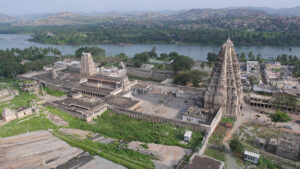
Virupaksha temple
The largest temple in Pattadakal is the 8th-century Virupaksha temple. It was built by Queen Lokamahadevi to commemorate her husband Vikramaditya II’s victory over the Pallavas. The rich sculptures of the temple include Nataraja, Lingodbhava, Ugranarasimha and Ravananugraha. Originally the temple was known as Lokapaleshvara or the Lokeshvara temple. This Dravidian style temple has three entrances on the north, south and east sides. The eastern side has a massive gateway.
The temple has a sanctum with a circuit path that ends at a square pedestal where the Shiva Linga is installed. The stone mantapa has imposing stone figures brilliantly carved and also inscriptions. A large stone bull is placed inside the four pillared Nandimantapa. The famous Kailasantha temple at Ellora was built following the model of the Virupaksha temple. The architect was honoured with the Tribhuvanacharya title.
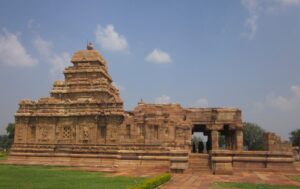
Sangameshvara temple
The oldest temple of Pattadakal is the Sangameshwara temple, earlier known as Vijayewara temple. It was built by Vijayaditya, the Chalukya king, from AD 696 to AD 733. This Dravidian style temple has a sanctum, navaranga and an inner passage.
A path for pradakshina encloses the sanctum and the inner passage. The figures of Nataraja and Ugranarasimha are sculptures on the outer walls. The Virupaksha temple and Sangameshwara temple hold similarity in many aspects. There are twenty pillars arranged in four rows in the navaranga. The main vimana consists of three storeys. The first storey is surrounded by walls, while in the second the inner walls are projected upwards. The circumambulatory round the sanctum is enclosed by the outer walls. The temple, although incomplete, remains attractive for its architectural excellence.

Chandrashekhara temple
The Chandrashekhara temple is a small temple of about 15 feet and is situated on the left side of the Sangameshwara temple. The architecture of the Chandrashekhara temple is quite simple. Standing on an adhishthana, the temple has a small garbhagriha where a Shiva Linga is installed on a pedestal.
On either side of the garbhagriha is a niche or devakosta. Shakhas are decorated on the doorframe of the shrine. On either side of the sanctum there is a dwarapala (guard) standing. There is a small hall inside the temple, the doorframe of which has shakhas carved on it.
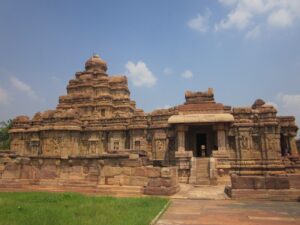
Mallikarjuna temple
The smaller version of the Virupaksha temple is the Mallikarjuna temple built by the second queen of Vikrmaditya, Trilokyamahadevi during AD 745. Earlier known as Trailokeshvara, this temple is situated on the northern side of Virupaksha temple. This temple was also built to commemorate victory of King Vikramaditya II over the Pallavas. Built immediately after the construction of Virupaksha temple, this place has a four storied viman.
The Dravidian style temple has a circular griva and sikhara. It holds similarity in construction, design and sculptures with the Sangameshvara temple, though smaller in size. Two female idols and a beautiful image of Narasimha putting Hiranyakashipu to death are seen in the porch. There are eighteen pillars in the navaranga that are decorated with figures from the Mahabharata, Ramayana and other epics, depicting the social strata of ancient times. The ceiling has figures of Shiva and Parvati, along with that of Nandi and Gajalakshmi. The external walls are beautified with sculptures of Shiva, Nataraja, Lakulisha and Nandi, among others.
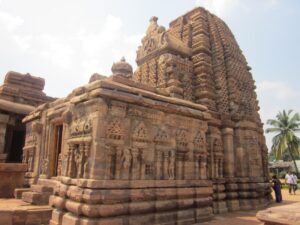
Kashivisvanatha temple
The Kashivishvanatha temple, built in the 8th century, was the last temple constructed in the early Chalukya style. The temple was built by the Rashtrakutas, and reflects the Nagara style of architecture. It is situated on the northern side of the Mallikarjuna temple.
The sanctum that has a rekhanagara tower and a passage are the only remains of the temple. Female figures are inscribed on the pillars of the inner passage while the ceiling represents Somaskanda.

Galganatha temple
Considered to be constructed during the first half of 8th century, the Galanatha temple faces west and lies on the northern side of the Virupaksha temple. Rekha Nagara Prasada was the architectural style adopted to construct it.
There is a sculpture of Lord Shiva in the posture of killing Andhakasura the demon. The temple has a sanctum with a Shiva Linga, a shukasana and a navaranga. A circuit path is built around the sanctum. Figures of Gajalakshmi, Kubera and others are installed in different niches. The figure of Lord Shiva is placed on the niche of the external wall of the pathway of the circuit. The tower of the temple portrays careful workmanship in the Rekhanagara style.
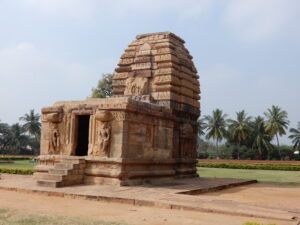
Kadasiddheswara temple
Built in the middle of the 7th century, the Kadasiddheswara temple rests on a plinth. The temple facing east has a square garbhagriha, that is sanctum that bears a linga of Lord Shiva on a plitha. Five sakhas decorate the doorway.
The architectural style projects the Rekha-Nagar form that is found in the northern part of India. The shukanasa showcases dancing Shiva and Parvati. Here Shiva is found holding a trishul (trident) in his hands. Images of Ardhanariswara, Siva and Harihara are present on the niches of the outer walls of the garbhagriha. Pilasters are set at the sanctum doorway, along with decorated sakhas and Shiva and Parvati are seated at the middle of the lintel, with Vishnu and Brahma on either side. Below the sakhas on either side, beautiful carvings of the river goddess and attendants are found. The Kadaisiddeshvara temple and the Jambulinga temple are called twin temples as both are built in Nagara style and hold resemblance with the Hucchimalli Guddi located at Aihole.
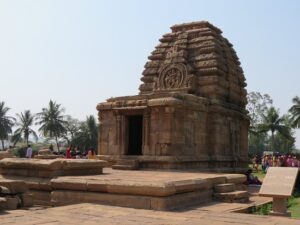
Jambulingeswara temple
This is the twin temple of the Kadaisiddeshvara temple. Built in the mid 7th century, the Jambulingeswara temple sits on a plinth with five mouldings. The topmost moulding is decorated with birds, miniature ganas and kudus. The temple faces east. The square sanctum has a Linga installed on a plinth, with a mandapa and a pranala on the north side. The basement of a Nandi mandapa and a raised platform in ruins are seen on the east side of the temple. A worn out image of Nandi in couchant position is present in the basement. Pilasters decorate the wall corners, niches and either side of the windows. The niches of the walls of the sanctum have sculptures of Shiva, Vishnu and Surya on the south, north and west sides respectively. The ceiling of the garbhagriha and the ends of the roof of the mandapa have carvings of makaras and vyalas, and the lower part of the corn rice is decorated with a frieze of swans.

Jain temple
Out of the ten shrines, the only Jain temples are situated on the Pattadakal Badami road. Locally called the Jaina Narayana temple, it was built by the Rashtrakutas of Manyakheta, presumably in the 9th century either by King Amoghavarsha or by his son Krishna II. This Dravidian style temple has beautiful sculptures and consists of a garbhagriha, a navaranga, a mukhamantapa and a shukanasa.

Papanatha temple
The Papanatha temple, built in AD 680, is located in the southern part of the Virupaksha temple. Construction of the temple started following the Nagara style, but was later changed to the Vesara style. Sculptures of the temple portray scenes from epics like the Mahabharata and the Ramayana. The temple resembles to some extent the Nababrahma temples in Alampur in the state of Andhra Pradesh that were also constructed by the Badami Chalukyas.
It consists of a sanctum that is circumscribed by a pathway, a portico, a large antechamber and a main hall. Idols of Nandi and Virabhadra are installed at the inner hall doorway. The main hall has sixteen pillars, ornamented with carvings of female figures and couples. Exquisite figures of Shiva and Parvathi, along with gandharvas and Vishnu, are carved on the ceiling. The wall on the northeast side has a remarkable figure of a royal court. Decorative carvings and sculptures of amorous couples are seen in different parts of the temple. The external walls are ornamented with scenes from the Ramayana and sculptures of lions and elephant riders.
The Group of monuments in Pattadakal designated under UNESCO World Heritage List, in 1987 as cultural property, under criteria (iii) and (iv).
Criteria (iv):
Pattadakal, in Karnataka, represents the high point of an eclectic art which, in the seventh and eighth centuries under the Chalukya dynasty, achieved a harmonious blend of architectural forms from northern and southern India. An impressive series of nine Hindu temples, as well as a Jain sanctuary, can be seen there. One masterpiece from the group stands out – the Temple of Virupaksha, built c. 740 by Queen Lokamahadevi to commemorate her husband’s victory over the kings from the South is considered the most outstanding architectural edifice.
Criteria (iii):
The evocative sanctuary ruins in the enclosure may be reached through monumental gates on the west and east sides. In the axis of the courtyard, before the temple, is a pavilion housing a black stone statue of Siva’s sacred bull.
Source:
https://www.mapsofindia.com/tourism/group-of-monuments-at-pattadakal.html
https://en.wikipedia.org/wiki/Pattadakal
https://archive.india.gov.in/knowindia/culture_heritage.php?id=40



